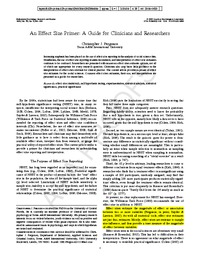An Effect Size PrimerA Guide for Clinicians and Researchers
Christopher J. Ferguson
Publikationsdatum:
|
 |
 Diese Seite wurde seit 1 Jahr inhaltlich nicht mehr aktualisiert.
Unter Umständen ist sie nicht mehr aktuell.
Diese Seite wurde seit 1 Jahr inhaltlich nicht mehr aktualisiert.
Unter Umständen ist sie nicht mehr aktuell.
 Zusammenfassungen
Zusammenfassungen
Increasing emphasis has been placed on the use of effect size reporting in the analysis of social science data.
Nonetheless, the use of effect size reporting remains inconsistent, and interpretation of effect size estimates
continues to be confused. Researchers are presented with numerous effect sizes estimate options, not all
of which are appropriate for every research question. Clinicians also may have little guidance in the
interpretation of effect sizes relevant for clinical practice. The current article provides a primer of effect
size estimates for the social sciences. Common effect sizes estimates, their use, and interpretations are
presented as a guide for researchers.
Von Christopher J. Ferguson im Text An Effect Size Primer (2009) This article presents a number of commonly used and important
effect size measures. It is worth noting that it is not possible to
describe all effect size measures available as they are quite numerous.
There are several resources to which the reader is referred
for further discussion (e.g., Cohen 1992; Sapp, 2006).
The current article is intended as an introductory primer for
researchers who may not be familiar with the range of effect size
estimates available to them, and when they should be used. No
effect size measure is perfect for all situations, and some disagreement
persists over the advantages of some over others. This article
is intended as a general guideline. Ultimately, researchers are
encouraged to select wisely (and conservatively) from among the
options presented. Interpretation of effect sizes will always remain
context specific. Accepting effect sizes of any magnitude as clinically
or practically significant renders their usefulness as moot.
Psychologists must be willing to objectively identify minute effects
and interpret them as such. Only by being realistic will we
know when we are actually on to something.
Von Christopher J. Ferguson im Text An Effect Size Primer (2009) auf Seite 123This article presents a number of commonly used and important
effect size measures. It is worth noting that it is not possible to
describe all effect size measures available as they are quite numerous.
There are several resources to which the reader is referred
for further discussion (e.g., Cohen 1992; Sapp, 2006).
The current article is intended as an introductory primer for researchers who may not be familiar with the range of effect size estimates available to them, and when they should be used. No effect size measure is perfect for all situations, and some disagreement persists over the advantages of some over others. This article is intended as a general guideline. Ultimately, researchers are encouraged to select wisely (and conservatively) from among the options presented. Interpretation of effect sizes will always remain context specific. Accepting effect sizes of any magnitude as clinically or practically significant renders their usefulness as moot. Psychologists must be willing to objectively identify minute effects and interpret them as such. Only by being realistic will we know when we are actually on to something.
Von Christopher J. Ferguson im Text An Effect Size Primer (2009) The current article is intended as an introductory primer for researchers who may not be familiar with the range of effect size estimates available to them, and when they should be used. No effect size measure is perfect for all situations, and some disagreement persists over the advantages of some over others. This article is intended as a general guideline. Ultimately, researchers are encouraged to select wisely (and conservatively) from among the options presented. Interpretation of effect sizes will always remain context specific. Accepting effect sizes of any magnitude as clinically or practically significant renders their usefulness as moot. Psychologists must be willing to objectively identify minute effects and interpret them as such. Only by being realistic will we know when we are actually on to something.
 Dieser Zeitschriftenartikel erwähnt ...
Dieser Zeitschriftenartikel erwähnt ...
 Personen KB IB clear | Jacob Cohen | ||||||||||||||||||
 Begriffe KB IB clear |  Daten Daten data
, Effektstärkeeffect size
, Effektstärken-Klasseneffect size classes
, data
, Effektstärkeeffect size
, Effektstärken-Klasseneffect size classes
,  Statistik Statistik statistics statistics
| ||||||||||||||||||
 Bücher |
|
 Dieser Zeitschriftenartikel erwähnt vermutlich nicht ...
Dieser Zeitschriftenartikel erwähnt vermutlich nicht ... 
 Nicht erwähnte Begriffe | Metaanalyse |
 Zitationsgraph
Zitationsgraph
 Zitationsgraph (Beta-Test mit vis.js)
Zitationsgraph (Beta-Test mit vis.js)
 2 Erwähnungen
2 Erwähnungen 
- Screens, Teens, and Psychological Well-Being - Evidence From Three Time-Use-Diary Studies (Amy Orben, Andrew K. Przybylski) (2019)


- Impact of digital screen media activity on functional brain organization in late childhood - Evidence from the ABCD study (Jack Miller, Kathryn L. Mills, Matti Vuorre, Amy Orben, Andrew K. Przybylski) (2023)


 Anderswo finden
Anderswo finden
 Volltext dieses Dokuments
Volltext dieses Dokuments
 |  An Effect Size Primer: Artikel als Volltext ( An Effect Size Primer: Artikel als Volltext ( : :  , 78 kByte; , 78 kByte;  : :  2020-11-28) 2020-11-28) |
 Anderswo suchen
Anderswo suchen 
 Beat und dieser Zeitschriftenartikel
Beat und dieser Zeitschriftenartikel
Beat hat Dieser Zeitschriftenartikel während seiner Zeit am Institut für Medien und Schule (IMS) ins Biblionetz aufgenommen. Beat besitzt kein physisches, aber ein digitales Exemplar. Eine digitale Version ist auf dem Internet verfügbar (s.o.). Aufgrund der wenigen Einträge im Biblionetz scheint er es nicht wirklich gelesen zu haben. Es gibt bisher auch nur wenige Objekte im Biblionetz, die dieses Werk zitieren.









 Biblionetz-History
Biblionetz-History